Posted by Elena del Valle on December 28, 2009
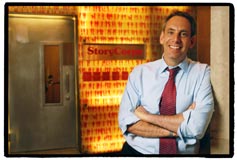
Dave Isay, founder and president, StoryCorps
Photos: Griot Initiative
Are you Hispanic and living in a city the United States or Puerto Rico? Are you comfortable with the idea of an audio recording? Is there a past experience you yearn to share with a friend and others you may never meet? If you answered yes to all these questions, you may want to participate in StoryCorps Historias, an ongoing national program for Latinos developed by Dave Isay of StoryCorps and funded by the Corporation for Public Broadcasting (CPB). The program, launched in New York City September 2009, will be in Miami, Florida January 7-30, 2010.
Part of the program’s outreach is done by partnering with local radio stations, cultural institutions and community-based organizations to collect recordings from 21 locations. In Miami, StoryCorps is partnering with WDNA-FM 88.9 Public Radio, which plans to air some of the local stories. Selected interviews will also air on Latino USA, an English-language news program broadcast in 31 states and NPR’s Morning Edition.
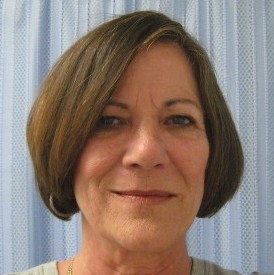
Maggie Pelleyá, general manager of WDNA-FM 88.9 Public Radio
“Miami is the gateway to the Caribbean as well as Central and South America, and everyone has a story of how they arrived here, how they work, how they raise their families, and how they consider Miami their home,” said Maggie Pelleyá, general manager of WDNA-FM 88.9 Public Radio. “WDNA is proud to host this opportunity to share the stories of many who consider Miami as the Magic City.”
According to a StoryCorps representative, participants are free to discuss anything they like, in English or Spanish, such as a favorite memory or important life questions. The StoryCorps Historias website lists some ideas and suggested questions for those seeking inspiration.
“StoryCorps reminds us of our shared humanity; by listening to our stories, we walk in the shoes of others and recognize how much we have in common,” said Isay, founder and president, StoryCorps in a press release about the upcoming Miami program. “We are proud to work with WDNA to help create a growing portrait of our nation’s fastest-growing minority group by preserving the stories of Latinos throughout the country.”
As part of the process, each participant, asked to donate $25, receives a broadcast quality copy of his or her recording. The fee will be waived for those who cannot afford to pay. A facilitator assists participants in the recording session. There are two bilingual facilitators in the program.
At the end the organization plans to select 1,000 recordings to collate together. Those recordings selected for broadcast and archiving in the Library of Congress will be edited and shortened with the participants permission. Also involved in the national initiative are Latino Public Radio Consortium, Latino USA and the U.S. Latino and Latina World War II Oral History Project.

A StoryCorps MobileBooth
Residents of San Francisco, California; Eastern Puerto Rico; Taos, New Mexico; Alamosa, Colorado; Austin and Houston, Texas; and Boston, Massachussets already participated in the program this year. In addition to Miami, the Mobile Booth, where the recordings take place, will visit: Yuma and Phoenix, Arizona January 4, 2010; San Juan, Puerto Rico January 20, 2010; Los Angeles, February 8, 2010, and Fresno, March 22, 2010 in California; as well as Washington, DC April 2010; Albuquerque, New Mexico May 17, 2010; Chicago, Illinois May 17, 2010; Brownsville, May, 2010, and San Antonio, June, 2010, in Texas; San Diego, California July, 2010 and Granger, Washington at a date to be determined.
StoryCorps plans to collect 120 stories in Miami. Its MobileBooth will be parked at the Wolfson Campus of Miami Dade County College for four weeks. Details can be found on the organization’s website, StoryCorps.org.
In addition to Historias, StoryCorps has three other initiatives: Griot, designed to preserve the voices, experiences, and life stories of African Americans; Memory Loss Initiative for people affected by memory loss; and 9/11 Initiative to honor and remember the stories of survivors, rescue workers, and others personally affected by September 11.
StoryCorps is an independent non-profit whose mission is to “honor and celebrate one another’s lives through listening.” According to promotional materials, StoryCorps has one of the largest archives of American voices ever created. Each week, StoryCorps broadcasts air on NPR’s Morning Edition. Other funders include The Atlantic Philanthropies, The Ford Foundation, The Annenberg Foundation, and Joe and Carol Reich.
Posted by Elena del Valle on December 21, 2009

Jude Law, Guy Ritchie and Robert Downey, Jr. on the set
Photos, video: Warner Bros.
That eccentric British detective is at it again. This time Robert Downey Jr. plays the famous fictional character and Jude Law his faithful sidekick. The latest reincarnation of Arthur Conan Doyle’s Sherlock Holmes is brought to the screen this Christmas Day by Director Guy Ritchie in the simply titled Sherlock Holmes, a Warner Bros. release. Scroll down to watch a film clip.
After a string of brutal, ritualistic murders, Holmes and Watson arrive in time to save the latest victim and uncover the killer, Lord Blackwood. He has terrorized inmates and jailers with his seeming connection to dark and powerful forces. As he approaches his scheduled hanging, Blackwood warns Holmes that death has no power over him. And when, by all indications, Blackwood makes good on his promise, his apparent resurrection panics London and confounds Scotland Yard. Fortunately for fans of the detective to Holmes, the game is afoot.
“He was probably the first superhero, an intellectual superhero,” said Downey Jr. “He was, and probably still is, one of the most recognizable icons on Earth, so much so that a lot of people actually thought that Sherlock Holmes was a real person. The more you look into Arthur Conan Doyle’s books, the more you see what a rich character Sherlock Holmes is. He’s very adept at so many things: he plays violin, he’s a martial artist, a boxer, an expert single stick fighter and a swordsman of sorts. He has a strong moral code in helping good guys catch bad guys, so he has dedicated his life to being a consulting detective. He doesn’t do it to show everyone how smart he is, or that he has figured everything else out when they haven’t; he’s actually a crusader.”

A scene in Sherlock Holmes
“We’ve tried to take him back to what we believe to be his origin, which is essentially a more visceral character,” said Guy Ritchie, who has been a Holmes fan since childhood. “We’ve tried to integrate that and make him more streetwise. He is inquisitive about chemistry, martial arts, and the human condition. Yet he managed to percolate through all the different echelons of English society, which was tremendously complex. But then, as now, Sherlock Holmes is unique; there’s really no one else like him. I think that’s why his appeal has stuck. And while our story is rooted in London of the 1890s, we have tried to make it as contemporary as we possibly can.”
Although a spokesperson indicated by email that “The studio will not be sending screeners for this film,” according to promotional materials, Holmes and Watson fight to bring down “a new nemesis and unravel a deadly plot that could destroy the country.” Other cast members include Rachel McAdams, Mark Strong, Eddie Marsan, and Kelly Reilly in the dark looking story. Michael Robert Johnson, Anthony Peckham and Simon Kinberg are responsible for the screenplay.
Posted by Elena del Valle on December 18, 2009

A scene in Falling Awake
Photos, video: Mega Films, IFC Entertainment
IFC Entertainment and Spanish Broadcasting System (SBS) are partnering to promote Falling Awake, a new film due to be released January 2010. The marketing partnership will be between IFC Film, part of IFC Entertaiment, and Mega Films, the film division of SBS. Scroll down to watch a 60-second video clip of Falling Awake.
IFC Films is scheduled to release the new movie in late January in New York and Miami with a simultaneous release nationwide on demand while SBS is scheduled to promote the film with a multi-million dollar advertising and promotion campaign on the company’s television, radio and online outlets.
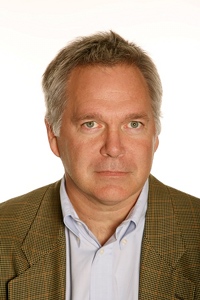
Jonathan Sehring, president, IFC Entertainment
“SBS and IFC together are a potent team and are ideal partners for the release of Falling Awake,” said Jonathan Sehring, president of IFC Entertainment, in a press release. “Our combined areas of expertise should ensure this terrific film finds the widest possible audience.”
Falling Awake, Mega Films’ first English-language production, stars Jenna Dewan (Step Up), Nicholas Gonzalez (Melrose Place) and Andrew Cisneros. The film was directed by Agustin (Gabriel, El Vacilon) and produced by Andrew Adelson. The executive producers were Steven Molasky, Dean Valentine, Brad Friedmutter and Raul Alarcon, (president, chief executive officer and chairman of SBS).
According to promotional materials, the movie sets out to illustrate the story of Jay (Andrew Cisneros), a young Latino musician in the Bronx who struggles to find his identity in a home crowded with family members and a neighborhood of loyal friends and dangerous enemies. His determination to find himself grows after he meets a beautiful Brooklynite, Alessandra (Jenna Dewan).
At the same time he is dealing with life issues like the loyalty he feels to his friends, his brother (Nicholas Gonzalez), who recently returned home from the war, and the expectations of his frustrated, angry father (Nestor Serrano). As Jay fights to break free of the cycles of anger and violence that grip his life, he finds that only love can give him a chance at happiness, and comes to a new understanding that helps him take the long, uncertain leap into his future.
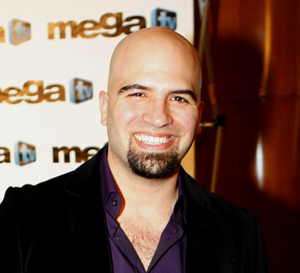
Agustin, director, Falling Awake
“It is fantastic to have the opportunity to work with a company like IFC Films that understands the strength and reach of SBS and Mega Films within the 40 million strong U.S. Hispanic market. I think the coming together of our audiences is precisely what Falling Awake is about,” said Agustin.
Spanish Broadcasting System (SBS), is one of the largest publicly traded Hispanic-controlled media and entertainment companies in the United States. The company owns or operates 21 radio stations, Mega TV, and LaMusica.com.
IFC Entertainment consists of multiple brands devoted to bringing specialty films to IFC Films, IFC Festival Direct, IFC Productions, and the IFC Center. IFC Films is a distributor of independent films. Its day and date distribution model, IFC In Theaters, releases independent films simultaneously in theaters, on cable’s On Demand platform and through Pay-Per-View. IFC Entertainment’s companies are subsidiaries of Rainbow Media Holdings LLC which in turn is a subsidiary of Cablevision Systems Corporation.
Posted by Elena del Valle on December 17, 2009
The RISD Museum of Art
The Museum of Art, Rhode Island School of Design seeks creative, experienced applicants for the position of Director of Museum Marketing.
The successful candidate will support the Museum’s outreach by planning, developing, coordinating and directing marketing, communications (including press and web presence) and publication initiatives, and visitor services to garner press coverage and develop audiences for the Museum’s exhibitions, programs and development initiatives.
Click here for the full text of Director of Museum Marketing
Posted by Elena del Valle on December 16, 2009
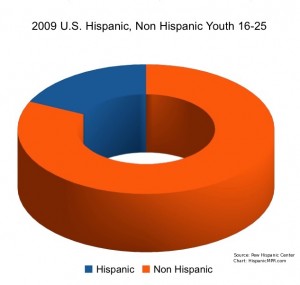
U.S. Hispanic, Non Hispanic Youth – click to enlarge
What’s on Latino youths minds? Why should business people, marketers and mainstream Americans care? According to the Pew Hispanic Center, this is the first time in the history of the United States that a minority ethnic group has represented such a large a share of the youngest Americans. Eighteen percent of people 16 to 25 in America claim Latino ethnicity. These young men and women represent an important part of the future of our country and will continue to do so for years to come since one of every four babies born in the United States today is Hispanic.
A recent Pew survey indicates Latinos 16 to 25 years old believe in the value of education, hard work and a career. These young people have in common a degree of satisfaction with their lives and optimism about their future. At the same time the youths that responded to the survey appear more likely to drop out of school, live in poverty and be teen parents than mainstream youths. The Pew researchers also believe many of these young people are exposed to gangs and live between two cultures. That may not be surprising since the researchers estimate almost one of four (22 percent) Hispanic youths between 16 and 25 are unauthorized immigrants.
The 150-page report, Between Two Worlds: How Latino Youths Come of Age in America, authored by the staff of the center, is based on analysis of government demographic, economic, education and health data sets; a series of focus groups; and a survey conducted between August 2009 and September 2009 among a random national sample of 2,012 Hispanics ages 16 and older, with an oversample of 1,240 Hispanics ages 16 to 25. The survey was conducted in English and Spanish by cellular and land line telephones.
Paul Taylor, director, Pew Hispanic Center wrote the report overview and edited the report. Rakesh Kochhar, associate director for research; Mark Hugo Lopez, associate director; Rich Morin, senior editor of the Pew Research Center’s Social and Demographic Trends project; and Richard Fry, senior research associate, also contributed chapter work to the report.
The report offers a generational analysis of the behaviors, values and experiences of Latino youth who are immigrants themselves (about one-third) and those who are the children and grandchildren (or higher) of immigrants and who responded to the survey.
Two-thirds of Hispanics ages 16 to 25 are native-born Americans. This year marks the first time that so many, 37 percent, of Latinos in this age group are the U.S.-born children of immigrants. An additional 29 percent are of third-or-higher generations while only 34 percent are immigrants themselves. Although Latinos only make up 18 percent of all youths 16 to 25 in the country in some states the percentage of Latinos in that age group is significantly higher: 51 percent of all youths in New Mexico, 42 percent in California, 40 percent in Texas, 36 percent in Arizona, 31 percent in Nevada, 24 percent in Florida and in Colorado.
Survey respondents expressed a strong preference to be identified with their family’s country of origin (52 percent) over American (24 percent) or the terms Hispanic or Latino (20 percent). One third of the U.S.-born children of immigrants identifies first as American and half of the third and higher generation identifies as American first.
The Pew Hispanic Center is a project of the nonpartisan, non-advocacy Pew Research Center. The complete report is available on the organization’s website.
Posted by Elena del Valle on December 15, 2009
An article profiling Elena del Valle, principal LNA World Communications and HispanicMPR editor and host, was published in the October 2009 issue of Somos Magazine for Hispanic Heritage Month. The Spanish language article was written by Luisa M. Fournier-Padró and also appears in the online edition of the publication at Somosonline.com.
Posted by Elena del Valle on December 14, 2009

Photos: Cecilia Moreno Yaghoubi
A podcast interview with Artist Cecilia Moreno Yaghoubi is available in the Podcast Section of Hispanic Marketing & Public Relations, HispanicMPR.com. During the podcast, she discusses her strategy in making it in the arts world as well as marketing tactics, initiatives and how to get visibility as an artist with Elena del Valle, host of the HispanicMPR.com podcast.
Social and political imagery, religious iconography, found objects, and mixed media all combine in Cecilia’s work of mix media assemblages with found objects. A Colombian-born artist Cecilia emigrated at a young age with her family to the United States. In time, she earned her Bachelor’s in Business Administration in marketing and began a career in property management. Working and living in the suburbs for the greater part of her life, she decided a little over six years ago to focus on her artwork, create a studio and pursue this venture full-time.
Through a combination of influences, Cecilia’s art has traveled from the lush and beautiful, yet safe and mainstream landscapes of her homeland to the more challenging, riskier mixed media work. Featuring political and social imagery, religious iconography and found objects such as dolls, much of her current work is assembled from flea markets, thrift shops and recycled materials like wood and fabric.

Virgin Mary, Assemblage Found Objects (dimensions 20 X 20 X 8 inches)
In 2005, Cecilia premiered her paintings at “Origenes Latinos/Latin roots” gallery in Chelsea, New York. She has exhibited in New York and Connecticut at the Silvermine Art Center, Westchester Art Workshop, Cork Gallery at Lincoln Center, the National Academy of Art Museum and at the Colombian Consulate of New York. In Miami, her work has been featured at Opera Gallery and had a solo exhibit, “Girl from Cali,” at the Colombian Consulate in Coral Gables in October 2009. In December 2009, she will be one of 800 artists from around the world invited to exhibit her artwork at the Biennale in Florence, Italy.
To listen to the interview, scroll down until you see “Podcast” on the right hand side, then select “HMPR Cecilia Moreno Yaghoubi” click on the play button below or download the MP3 file to your iPod or MP3 player to listen on the go, in your car or at home. To download it, click on the arrow of the recording you wish to copy and save it to disk. The podcast will remain listed in the December 2009 section of the podcast archive.
Posted by Elena del Valle on December 11, 2009
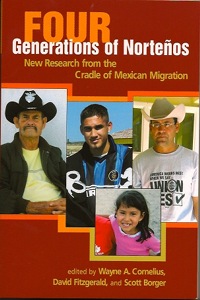
In Four Generations of Norteños New Research from the Cradle of Mexican Migration (Center for Comparative Immigration Studies, $24.50) edited by Wayne A. Cornelius, David Fitzgerald and Scott Borger twenty nine authors share insights on the migration of people over decades between central Mexico and the United States. Their findings are based on many years of data gathered from fieldwork and thousands of recent interviews. The authors examine complex issues such as smuggling people across the Mexico United States border, border enforcement and its possible impact on immigration decisions, and migration’s effect on families, health and the economy of the region.
The 250-page paperback book is divided into eight chapters: The Dynamics of Migration: Who Migrates? Who Stays? Who Settles Abroad?; Is U.S. Border Enforcement Working?; Coyotaje: The Structure and Functioning of the People-Smuggling Industry; Jumping the Legal Hurdles: Getting Green Cards, Visas and U.S. Citizenship; Development in a Remittance Economy: What Options Are Viable?; Outsiders In Their Own Hometown? The Process of Dissimilation; Families in Transition: Migration and Gender Dynamics in Sending and Receiving Communities; and The Migrant Health Paradox Revisited.
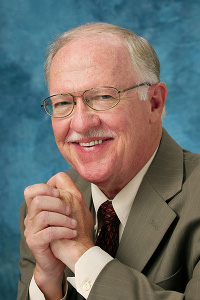
Wayne A. Cornelius, director emeritus, Center for Comparative Immigration Studies (CCIS)
Cornelius is director emeritus, Center for Comparative Immigration Studies (CCIS), University of California-San Diego as well as Distinguished Professor of Political Science and Theodore E. Gildred Chair in U.S.-Mexican Relations at that university. Fitzgerald, associated director, CCIS is author of A Nation of Emigrants: How Mexico Manages Its Migration. Borger is a Ph.D. candidate in economics at the University of California, San Diego.
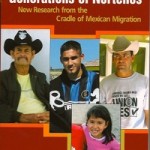
Click here to buy Four Generations of Nortenos
Comments:
Filed Under: Books
Posted by Elena del Valle on December 9, 2009
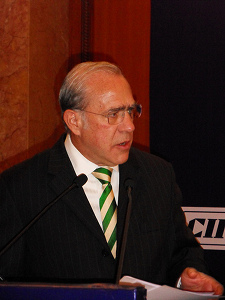
Angel Gurría, secretary-general, OECD
Photo: Organization for Economic Co-operation and Development (OECD)
In spite of the recent talk of job related improvements, millions of Americans have suffered the ill effects of unemployment. Teenagers have been hit especially hard. For example, in November 2009, more than 25 percent of 16 to 19 year-old Americans were unemployed compared to ten percent for all workers. This is said to be the highest rate of teenage unemployment in the U.S. since World War II.
According to Jobs for Youth: United States, a 170-page report released this month by the Organization for Economic Co-operation and Development (OECD), in the year to November 2009, the youth unemployment rate in the United States rose by 8 percentage points to 19 percent representing an additional 1.6 million young people out of work.
“The short-term priority must be to help the young people most at risk to avoid the long-term scarring of a generation of young Americans,” said Angel Gurría, secretary-general, OECD in a news release. “Business must play its part in creating jobs but the government has to act quickly to extend financial support to more young people and increase funding for re-employment programmes. Longer-term, investing more in education to give young people the skills they need to succeed is essential.”
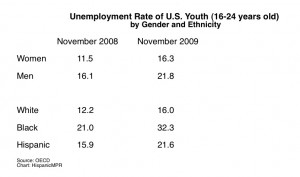
Unemployment in U.S. Youth 2008-2009 – click to enlarge
As recently as 2007, the youth employment rate was 53 percent. While not ideal, especially when compared with 60 percent in 2000; the youth unemployment rate, at 11 percent, was about 1 percentage point higher than its 2000 level. The report summary predicts African-American youth, youth with no qualifications and young women are particularly to face increasing challenges.
Jobs for Youth: United States is the latest in a series of OECD reports on youth employment policies that covers 14 countries. OECD provides a forum for member governments to compare policy experiences, “seek answers to common problems, identify good practice and coordinate domestic and international policies.”
Target Latinos effectively by understanding how they shop
“Hispanic Holiday Shopping Patterns” audio recording

Manuel Delgado, CEO Agua Marketing, gives a presentation and participates in an extended Q&A discussion about
- Hispanic shopping patterns national survey
- Why Latino consumers may be more desirable than general market shoppers
- Hispanics holiday shopping patterns and behaviors
Click here for information on “Hispanic Holiday Shopping Patterns” audio recording
Posted by Elena del Valle on December 7, 2009

Dr. Lepora with Dr. Krueger in surgery in Liberia
Photo and videos: Red Floor Pictures Production
In mid 2005, Mark Hopkins began production of a film about Medecins Sans Frontiers (MSF), the well known international emergency assistance organization spearheaded by volunteer physicians and health care providers, and its work, mostly in Africa. It required much convincing and gaining of trust on his part to win Doctors Without Borders, as it is known in English, over to the idea of a no holds barred film of their volunteers in the field. Hopkins describes the film as exploring the limits of idealism. Scroll down to watch two video clips of the documentary.
“I hope they get a sense of what life in the field is like for MSF doctors. Beyond that, hopefully an unburdened sense of interest in the humanitarian arena: an understanding that these guys are not heroes, they’re not saving the world, and that the work is engaging and rewarding in its own right – it doesn’t need ideas of big accomplishment to justify itself – the patient in front of you is more than enough. We didn’t make the film to deliver a message, the idea was more to immerse people in the MSF environment,” said Hopkins about the purpose of the project and what he hopes the audience gains from viewing the film.
Nearly four years after filming of Living in Emergency began the film is ready to open in theaters nationwide as a Red Floor Pictures release. Ten people worked on the project made possible with a modest $1.7 million budget provided by private individuals who the promoters declined to identify.
“The reason for the time delay is that documentaries take a long time to make. The crew began filming in mid-2005 and filmed on and off for 12 months. The editing ran for 18 months. The film was finished in 2008, premiered at the Venice Film Festival, spent the last 12 months playing at festivals, and is now building up to its widespread release,” a film spokesperson explained when asked about the delay between the film and release dates.
From July to September 2005, the crew filmed in Beni and Kayna, two towns in the Democratic Republic of Congo (DRC), especially the MSF hospital and its environs. Next, they traveled to the Liberian capital of Monrovia to film at MSF’s Mamba Point Hospital, where MSF was providing emergency care following the Liberian Civil War; and to the remote northern towns of Foya and Kolohun.
In October 2005, the crew traveled to Kashmir, Pakistan to film the MSF emergency response to the 7.6 magnitude earthquake. In 2006, they returned to Africa, to revisit Mamba Point Hospital, and traveled to Malawi to see the MSF AIDS program. Additional film locations included Paris, France, Montreal, Canada, Niger, Kenya, and Tennessee, United States. The production was organized to cover the various facets of the MSF organization such as the administrative base, conflict and post-conflict missions, and response to natural disasters.
Hopkins, born in Puerto Rico and raised in Italy and Kenya, worked for producer Scott Rudin for several years before producing his first solo documentary film. He was most recently the producer of Going Upriver: The Long War of John Kerry. Living in Emergency is his directorial debut. Bruno Coulais, composer, and Bob Eisenhardt, senior editor, also contributed to the film.
Doctors Without Borders/Médecins Sans Frontières (MSF) is an international medical humanitarian organization created by doctors and journalists in France in 1971 that strives to provide independent, impartial assistance to those most in need. The organization, a recipient of the 1999 Nobel Peace Prize, provides aid in more than 60 countries to people whose survival is threatened by violence, neglect, or catastrophe, primarily due to armed conflict, epidemics, malnutrition, exclusion from health care, or natural disasters.
According to promotional materials, on any one day, more than 27,000 individuals representing dozens of nationalities are providing assistance to people caught in crises around the world. They are doctors, nurses, logistics experts, administrators, epidemiologists, laboratory technicians, mental health professionals, and others who work together in accordance with MSF’s guiding principles of humanitarian action and medical ethics. The majority of these aid workers are from the communities where the crises are occurring; only ten percent of teams are made up of international staff.
Comments:
Filed Under: Video




























